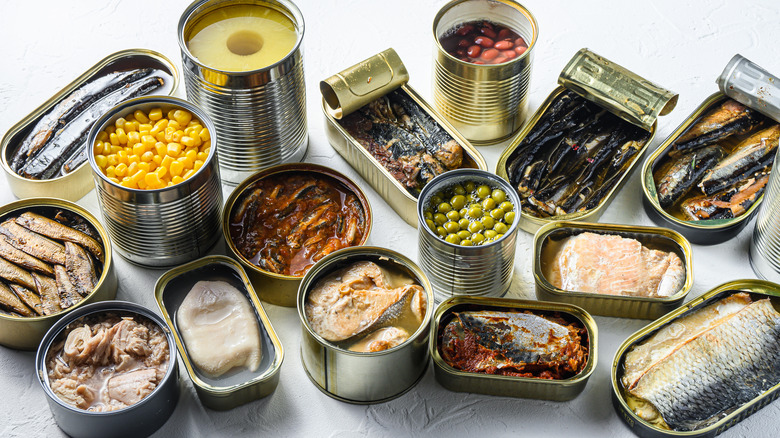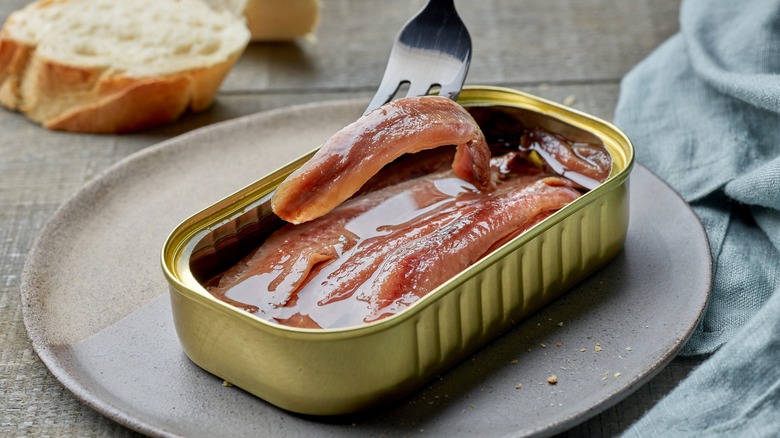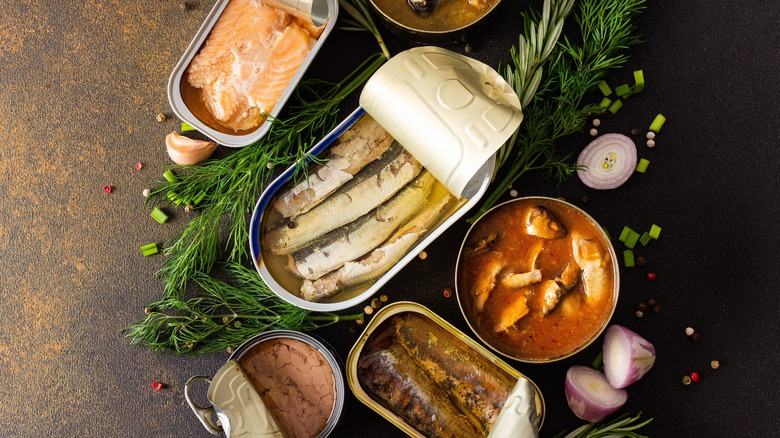Canned Sardines Vs Anchovies: Is There A Nutritional Difference?
Both anchovies and sardines are growing in popularity. After years of collecting dust in the canned section of the grocery store, and often carrying an unappetizing reputation, tinned fish varieties are finally getting their due. Canned sardines and anchovies are small, oily saltwater fish that have been a staple in many recipes for years. And though both types of fish make great additions to many meals, they have caught on in recent years due to an uptick in the popularity of canned foods and a growing number of higher-quality canned fish brands on the market.
However, you might be wondering what the difference is between these two very similar foods, especially when it comes to nutrition. The two fish do contain many similarities, and both pack a wallop of healthy fats. One thing they have in common are their high levels of beneficial omega-3s. A serving of anchovies canned in oil contains 2 grams of omega-3s, and sardines contain 1.6 grams per serving. Both fish are also relatively high in protein, with anchovies containing 29 grams of protein per serving and canned sardines containing 25 grams of protein per serving. Where the two forms of canned fish differ, however, is in their sodium content. This is because anchovies are often salt-cured and are therefore higher in sodium.
In fact, anchovies contain about 150% of the recommended daily serving of sodium per serving. And while sardines are also sodium-rich, they are significantly lower in sodium than anchovies, containing 21% of the recommended daily serving. And this is perhaps the biggest difference between the two fish.
When to use which
However, just because anchovies are saltier doesn't mean you should avoid them. Their high sodium content lends to their umami flavor and makes them a perfect addition to such foods as salad dressings and pasta sauces. Canned anchovies feature a strong and salty taste that accents these foods and brings an intense saltiness that can offset other ingredients. However, you may want to decrease the amount of salt (or other salty ingredients) you add to anchovy-rich recipes to balance the flavor. Anchovies also work well in pasta sauces and salad dressings because they break down more easily than sardines, which tend to be slightly bigger and have more solid bones. Anchovies also make a great pizza topping, contrasting the mild mozzarella and slightly sweet tomato sauce.
Canned sardines, on the other hand, have a slightly subtler flavor thanks to their lower sodium content, and therefore make for a great main protein in a dish. Canned sardines have seemingly endless uses. For starters, they can serve as a delicious topping for salads or pasta, and they make for a fantastic sandwich filling or served pan-fried with sauce.
How canning changes the fish
Of course, the canning process itself has a big impact on the nutrient content of both sardines and anchovies. The canning process increases the sodium content of both fish, so fresh versions of these fish are best for people watching their salt intake. That said, if you use fresh anchovies, you can't count on the same salty flavor punch that you'll get from their canned counterparts.
Additionally, most sardines and anchovies are also packed in oil, adding more fat (and flavor) to an already oily fish. This oil used for canning can also be used to infuse flavor into the dishes you incorporate your fish into. This is especially tasty when the oils used for canning have ingredients added, such as peppers. This can help you to make use of all of your ingredients and add an extra punch to your sardine- or anchovy-infused recipe.
Despite the extra sodium, the canning process doesn't completely diminish the nutritional content of anchovies and sardines. The two fish still maintain high levels of omega-3s even after being canned. Additionally, both fish also contain a variety of healthy micronutrients that make the fish a great protein of choice. Both canned sardines and anchovies, for example, have high levels of selenium and calcium. So the next time you're considering your protein of choice for your next meal, don't knock the little canned fish.


